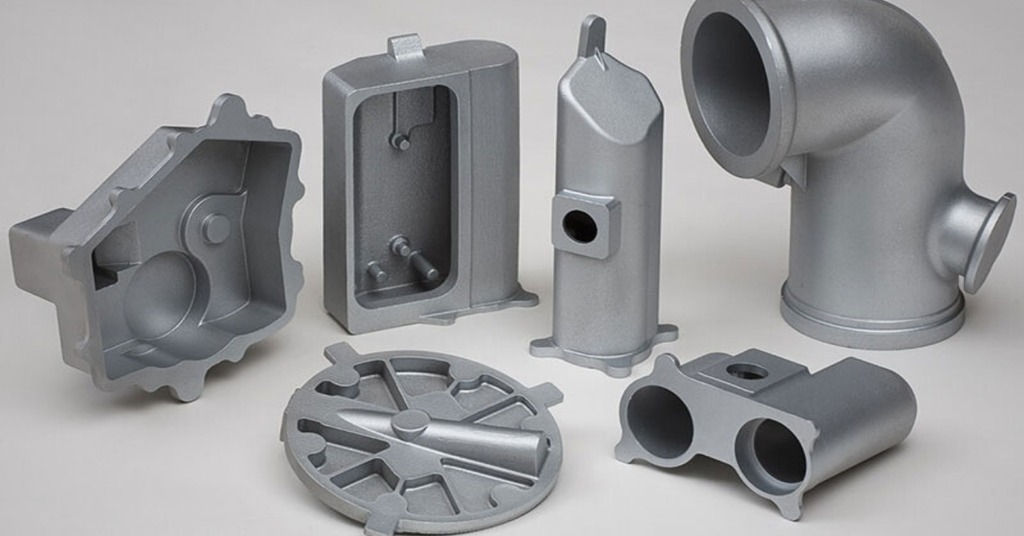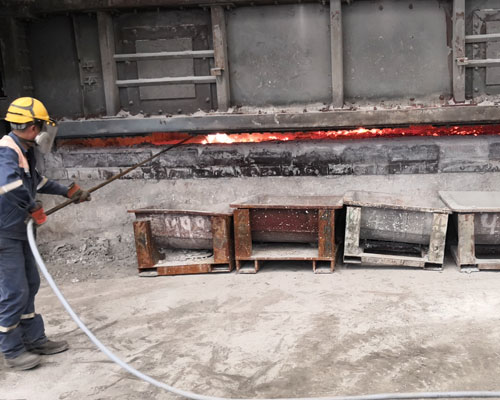Aluminum Foundry serves as the backbone of innovative aluminum casting production
Wiki Article
A Comprehensive Guide to the Manufacturing Techniques Employed in an Aluminum Foundry
The production techniques utilized in light weight aluminum foundries are critical and varied to the market. Each technique, from sand casting to additive production, provides unique benefits tailored to details production needs. Comprehending these techniques can significantly influence item high quality and performance. As the demand for sophisticated manufacturing remains to grow, the importance of grasping these methods can not be overemphasized. What ramifications do these advancements hold for the future of light weight aluminum manufacturing?Understanding Aluminum Alloys and Their Residence
Aluminum alloys play a crucial function in the production process because of their varied residential or commercial properties and applications. These alloys are mainly classified into two teams: wrought and cast alloys, each with distinctive attributes. Wrought alloys, such as the 6000 and 7000 collection, are known for their excellent strength-to-weight ratio and rust resistance, making them suitable for structural applications. In contrast, cast alloys, consisting of the 2000 and 3000 collection, display premium fluidity and can be conveniently formed right into complicated forms.
The particular properties of aluminum alloys, such as tensile strength, ductility, and thermal conductivity, are affected by their chemical composition and processing techniques. Elements like magnesium, copper, and silicon are commonly added to improve these properties, tailoring the alloys for specific usages in aerospace, automobile, and building industries. Comprehending these alloys and their actions is vital for maximizing production processes and making certain premium results in light weight aluminum Foundry procedures.
Sand Spreading: A Standard Approach for Aluminum Manufacturing
Sand spreading is an extensively utilized method in light weight aluminum manufacturing that includes producing a mold and mildew from sand to shape the steel. This technique supplies a number of benefits, such as cost-effectiveness and the ability to create intricate shapes, while also offering certain disadvantages, including surface area finish restrictions and slower manufacturing prices. Aluminum Foundry. Comprehending both the process and its pros and disadvantages is crucial for reviewing its suitability in numerous applicationsProcess Review
One of one of the most long-lasting strategies in metal casting, sand casting offers a reputable approach for creating light weight aluminum parts. This procedure starts with developing a mold from a mix of sand and a binding agent, which is formed to match the preferred component. When the mold and mildew is prepared, liquified light weight aluminum is put into the dental caries, allowing it to load the area and take on the mold and mildew's shape. After cooling, the mold is escaped to disclose the actors aluminum component. Any necessary finishing procedures, such as machining or surface therapy, can after that be put on attain the final specs. Sand casting is extensively used due to its versatility, enabling the production of complex shapes and varying dimensions effectively.Downsides and advantages
The sand casting procedure provides a distinct collection of advantages and drawbacks that affect its application in aluminum manufacturing. One substantial advantage is its versatility, permitting for the production of intricate shapes and dimensions. Furthermore, sand spreading is economical for reduced to tool manufacturing quantities, requiring marginal tooling. Nonetheless, it additionally has downsides, such as reduced dimensional precision and surface area coating compared to advanced methods. The procedure can be labor-intensive, needing experienced labor for mold and mildew prep work and putting. The production rate may be slower, limiting its effectiveness for high-volume applications. In general, while sand casting continues to be a feasible choice for lots of light weight aluminum elements, its limitations should be taken into consideration in the context of specific manufacturing demands.Die Spreading: Precision and Efficiency in Production
Die casting stands as a keystone of aluminum Foundry production, using unparalleled accuracy and effectiveness. This technique includes forcing liquified aluminum into a steel mold and mildew under high pressure, causing consistent and extremely precise elements. The process permits limited tolerances and intricate styles, making it excellent for applications in vehicle, aerospace, and customer items.The efficiency of die spreading appears in its rapid production prices, which substantially decrease preparations. Furthermore, the approach decreases waste, as excess steel can be recycled. The durability of die-cast parts boosts the longevity of items, decreasing the demand for frequent substitutes.
Pass away spreading supports numerous surface coatings and second operations, adding to its convenience. This combination of accuracy, rate, and product conservation settings pass away casting as a recommended selection for manufacturers seeking cost-efficient solutions without compromising quality. In the affordable landscape of aluminum Foundry techniques, pass away casting remains a vital technique.
Investment Spreading: Achieving Facility Geometries
Often eclipsed by die spreading, financial investment casting plays a significant function in light weight aluminum Foundry manufacturing by making it possible for the production of elements with intricate geometries and fine details. This method entails producing a wax pattern, which is covered in a ceramic covering. Once the shell solidifies, the wax is disappeared, leaving a cavity that reflects the wanted form of the end product.Investment spreading is specifically advantageous for creating complicated components that may be impossible or hard to attain via various other techniques. The process enables high dimensional accuracy and a smooth surface coating, decreasing the need for extensive machining. Furthermore, it supports a wide variety of alloys, enhancing its versatility in making applications. By making use of investment spreading, factories can satisfy the demands of industries such as aerospace, automotive, and medical, where accuracy and complexity are vital.
The Duty of Additive Production in Aluminum Foundries
Additive production is significantly identified for its transformative potential in light weight aluminum factories, using advantages such as lowered product waste and improved layout adaptability. Various methods, consisting of 3D printing and binder jetting, are being embraced to streamline manufacturing processes and improve performance. As the market progresses, future fads may better integrate additive production, improving conventional Foundry methods.Benefits of Additive Production
As the production landscape evolves, the combination of additive production in light weight aluminum factories offers a transformative change in manufacturing abilities. This innovative approach uses several considerable benefits, consisting of lowered product waste, as it permits specific layering and marginal excess. Additionally, additive manufacturing helps with fast prototyping, making it possible for quicker iterations and adjustments throughout the style phase. This innovation likewise sustains the production of complicated geometries that standard techniques may battle to attain, boosting product capability and efficiency. Additionally, it can simplify supply chains by making it possible for local manufacturing, minimizing transportation costs and lead times. Eventually, the fostering of additive manufacturing equips aluminum shops to improve effectiveness, enhance product top quality, and satisfy the expanding need for personalization in manufacturing.
Common Strategies Used
Discovering the landscape of aluminum shops discloses a selection of usual techniques that leverage additive production to improve production processes. One common method is the usage of 3D printing for producing intricate molds, which permits elaborate layouts that standard approaches can not attain. This method lowers material waste and reduces lead times significantly. In addition, binder jetting is employed to generate sand molds directly from electronic versions, improving the manufacture procedure. An additional approach includes the integration of steel additive production, which makes it possible for the manufacturing of extremely personalized light weight aluminum parts. These methods not just enhance efficiency but additionally add to advancement in layout, enabling shops to satisfy diverse client requirements while preserving top notch standards.
Future Patterns in Industry
While the light weight aluminum Foundry market has actually commonly relied upon traditional production techniques, the assimilation of additive manufacturing is poised to redefine production paradigms. This innovative technique enables for the creation of intricate geometries that are frequently difficult to achieve with typical spreading techniques. By making it possible for rapid prototyping and reducing material waste, additive manufacturing improves effectiveness and sustainability within aluminum factories. Additionally, this modern technology promotes personalization, permitting producers to meet details client requirements without comprehensive retooling. As the sector accepts digitalization, improvements in 3D printing technologies will likely lead to much faster manufacturing cycles and minimized lead times. The future of aluminum shops is significantly linked with the benefits and capacities used by additive production. Supplied Quality Assurance Steps in Aluminum Foundries Quality control procedures in light weight aluminum shops are fundamental to assure the stability and performance of actors items. These steps consist of extensive assessment procedures, which include both aesthetic analyses and advanced screening methods such as X-ray radiography and ultrasonic testing. Keeping an eye on crucial specifications, such as temperature level and alloy structure throughout the melting and pouring procedures, is essential to guarantee the desired product residential properties.Additionally, adherence to standardized treatments, such as ISO certifications, aids maintain constant top quality. Analytical process control (copyright) strategies are commonly employed to assess production data, permitting the recognition of fads and prospective flaws early in the production cycle.

Future Fads and Advancements in Light Weight Aluminum Casting Techniques
As the aluminum casting sector advances, innovative methods are emerging to boost performance and product top quality. One noteworthy fad is the combination of sophisticated automation and robotics, which improve processes and reduce labor costs. This change permits constant accuracy in spreading, decreasing flaws and enhancing general outcome.Furthermore, the adoption of 3D printing modern technology for pattern-making is getting grip, making it possible for rapid prototyping and the manufacturing of intricate geometries that conventional techniques battle to attain. The use of simulation software program assists in extra precise forecasts of product habits during casting, leading to maximized layouts and minimized waste.
Sustainability is additionally a centerpiece, with efforts toward reusing light weight aluminum scrap and embracing green practices in shops. These technologies reflect a commitment to progressing light weight aluminum casting techniques, ensuring boosted efficiency, reduced environmental influence, and versatility to market needs. The future of aluminum spreading assures significant innovations that will improve the industry landscape.
Often Asked Inquiries
What Security Steps Are Applied in Aluminum Foundries?
Precaution in aluminum shops consist of individual protective equipment, ventilation systems, normal security training, emergency situation procedures, and monitoring for hazardous materials (Aluminum Foundry). These practices aim to minimize dangers connected with heats and potential chemical exposureExactly How Is Waste Managed in Aluminum Spreading Processes?
Waste administration in aluminum casting procedures normally involves reusing scrap metal, making use of appropriate control for unsafe materials, and employing effective filtering systems. These techniques minimize ecological influence and promote source sustainability throughout the production cycle.What Environmental Regulations Effect Light Weight Aluminum Foundries?
Environmental guidelines considerably impact light weight aluminum foundries by enforcing criteria on exhausts, garbage disposal, and energy intake. Conformity guarantees sustainable methods, minimizes ecological impacts, and promotes the liable use of sources throughout the aluminum production procedure.How Do Factories Handle Equipment Maintenance and Repairs?
Shops normally execute scheduled maintenance Aluminum Foundry programs, carrying out normal maintenances to guarantee equipment operates effectively. They might utilize customized specialists and make use of anticipating upkeep innovations to decrease downtime and boost general functional performance.What Are the Normal Lead Times for Light Weight Aluminum Spreading Projects?
Common lead times for light weight aluminum casting tasks can vary considerably, typically ranging from a couple of weeks to a number of months. Aspects affecting these timelines consist of task complexity, product accessibility, and the Foundry's present workload and capacity.Sand casting is a widely made use of technique in light weight aluminum manufacturing that entails producing a mold from sand to form the metal. One of the most enduring techniques in metal spreading, sand casting offers a trustworthy method for creating aluminum components. The sand spreading process presents a special collection of benefits and downsides that influence its application in aluminum production. Frequently outweighed by die spreading, investment spreading plays a substantial role in aluminum Foundry manufacturing by allowing the development of parts with elaborate geometries and great information. Waste administration in aluminum casting processes typically involves reusing scrap metal, utilizing appropriate control for harmful materials, and employing reliable filtration systems.
Report this wiki page